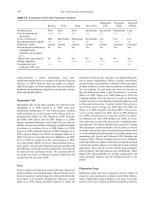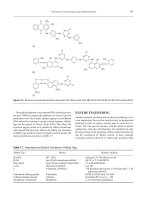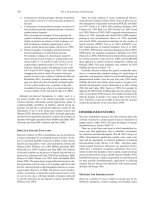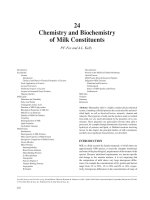8 food biochemistry and food phần 166
Bạn đang xem bản rút gọn của tài liệu. Xem và tải ngay bản đầy đủ của tài liệu tại đây (193.11 KB, 5 trang )
P1: SFK/UKS
BLBS102-c43
P2: SFK
BLBS102-Simpson
March 21, 2012
14:30
Trim: 276mm X 219mm
Printer Name: Yet to Come
821
43 Biogenic Amines in Foods
Acetylcholine
βPhenylethylamine
Histamine
HisƟdine
Synephrine
Dopamine
Tyramine
Octapamine
2-Amino-1-methyl-6-phenylimidazo [4,5-b]
pyridine (PhIP)
2-Amino-3,8-dimethylimidazo-[4,5-f]quinoxaline
(MeIQx)
2-Amino-3-methylimidazo[4,5-f]quinolone
(IQ)
2-Amino-3,4-dimethylimidazo-[4,5f]quinoxaline (MeIQ)
Figure 43.1. Structures of some common biogenic amines.
the enzyme choline acetyl transferase. In the PNS, ACh acts to
activate muscles, while in the CNS, it elicits excitatory actions.
Histamine is derived from the amino acid histidine via decarboxylation by histidine decarboxylase. It is a neurotransmitter
and is produced by basophiles and mast cells, and functions in
immune response and the regulation of physiological functions
in the gut (Marieb 2001). Histamine enhances the permeability
of capillaries to white blood cells and protein antibodies, which
are needed to destroy foreign substances and nullify their harmful effects. It also acts in pro-inflammatory response to tissue
damage or allergic reactions and also enhances the secretion of
gastric HCl through histamine receptors.
Tyramine is formed from the amino acid tyrosine by decarboxylation, and it occurs in many common foods that humans
P1: SFK/UKS
BLBS102-c43
P2: SFK
BLBS102-Simpson
822
March 21, 2012
14:30
Trim: 276mm X 219mm
Printer Name: Yet to Come
Part 8: Food Safety and Food Allergens
Figure 43.3. Scheme for the synthesis of adrenaline (epinephrine)
from tyrosine.
Figure 43.2. Scheme for the biosynthesis of serotonin from
tryptophan.
ingest or consume. Well-known food sources of tyramine include
fermented, pickled and aged foods, marinated foods, smoked
foods, chocolate, alcoholic beverages, and spoiled foods. Its
production and accumulation in the body have been linked to
elevated blood pressure and headaches.
Serotonin, known systematically as 5-hydroxytryptamine,
is synthesized from l-tryptophan by a series of reactions
(Fig. 43.2), including hydroxylation, decarboxylation, and
deamination steps. These reactions involve the participation
of several enzymes, including tryptophan hydroxylase (TPH),
5-hydroxytryptophan decarboxylase, and monoamine oxidase
(MAO). Serotonin is a neurotransmitter found mostly in the
gastrointestinal tract (GIT), the CNS, and platelets of animals
including humans. In the GIT, serotonin acts to regulate intestinal movements; in the CNS, serotonin performs various functions, including the regulation of appetite, mood, and sleep,
as well as muscle contraction and some cognitive functions
(Berger et al. 2009). Platelet-related serotonin is involved in
haemostasis and liver regeneration (Lesurtel et al. 2006). In
plants, serotonin is thought to be produced as a mechanism
for obviating the build-up of toxic ammonia. This involves
the coupling of NH3 to the indole of l-tryptophan followed
by decarboxylation into tryptamine and subsequently by cytochrome P450 (Cyt P450 ) monooxygenase-mediated hydroxylation to serotonin. Plant sources of serotonin include mushroom, tomato, plantain, banana, plum, kiwifruit, walnut, and
hickory. Excessive levels of serotonin can be toxic to humans
and is manifested by specific cognitive, autonomic, and somatic
effects that may range from nondetectable to fatal (Boyer and
Shannon 2005).
Tryptamines are a group of alkaloid compounds found in
plants, animals, and fungi. Well-known tryptamines include
serotonin and melatonin. These compounds are known for their
psychotropic effects and this forms the basis of their use by some
people; examples include psilocybin (from “magic mushrooms”)
P1: SFK/UKS
BLBS102-c43
P2: SFK
BLBS102-Simpson
March 21, 2012
14:30
Trim: 276mm X 219mm
Printer Name: Yet to Come
43 Biogenic Amines in Foods
and dimethyltryptamine (Jones 1983). There are also synthetic
counterparts of tryptamines, and these include the drug sumatriptan and its derivatives used to treat migraines (Yen and Hsieh
1991).
NE or NA is synthesized in the adrenal medulla and the neurons of the sympathetic nervous system from tyrosine via several enzyme-catalyzed reactions including hydroxylation followed by decarboxylation to dopamine and a final oxidation
step. The enzymes involved in the reactions are tyrosine hydroxylase, DOPA decarboxylase, and dopamine β-hydroxylase, respectively (Aston-Jones et al. 2002). The NE (or NA) compound
serves multifunctions, as a stress hormone, a neurotransmitter,
and as a drug. As stress hormone, it is involved in triggering
responses such as increasing heart rate, facilitating release of
glucose from storage depots, and increasing blood flow to the
skeletal muscle; as a neurotransmitter, it is released in the brain
to mitigate inflammations; and as a drug, it can increase vascular
tone and blood pressure.
Epinephrine or adrenaline is synthesized in the adrenal gland
from the amino acids phenylalanine and tyrosine via a series of
intermediates (Fig. 43.3). In the first step, tyrosine is oxidized
to l-DOPA, followed by decarboxylation to dopamine, which
is subsequently oxidized to NE and then methylated to form
adrenaline or epinephrine. It functions both as a hormone and as
a neurotransmitter and carries out manifold functions in the body.
For instance, it increases heart rate, modulates dilation of blood
vessels and air passages, and participates in the fight/flight response of the sympathetic nervous system. It also participates in
the contraction of the smooth muscles; inhibits insulin secretion
while enhancing glucagon secretion in the pancreas; and also
stimulates glycolysis in the muscle, lipolysis in adipose tissues,
and glycogenolysis in the liver and the muscle (Cannon 1929).
Dopamine, also known as 4,2-aminoethyl benzene-1,2-diol,
has a molecular formula of C6 H3 (OH)2 (CH2 )2 NH3 . It is synthesized by nervous tissues and the adrenal medulla from tyrosine (l-Tyr) by hydroxylation to form dihydroxyphenyl alanine
(l-DOPA) in a reaction catalyzed by tyrosine hydroxylase, followed by a decarboxylation step catalyzed by DOPA decarboxylase (Fig. 43.3). Dopamine thus formed may be processed
further into NE by the enzyme dopamine β-hydroxylase and
then methylated into epinephrine (Fig. 43.3). Dopamine is involved in motivation, addictions, behavioral manifestations, and
coordination of bodily movements (Yen and Hsieh 1991).
Other commonly known biogenic amines and their precursors include cadaverine, agmatine, β-phenylethylamine, and
putrescine derived, respectively, from lysine, arginine, phenylalanine, and ornithine. Polymerization of putrescine forms the
polyamines spermine and spermidine (Pegg and McCann 1982).
These polymeric products are highly resistant to degradation
during processing and are capable of withstanding procedures
like canning, freezing, smoking, and cooking (Etkind and Wilson 1987). Some biogenic amines are present at low levels in
fresh foods; however, these levels may increase via microbial
decarboxylation of free amino acids during processes such as
fermentation, storage, and in food spoilage. Various factors such
as pH, temperature, salt concentration, and glucose availability
all influence the formation of biogenic amines in foodstuffs.
823
The importance of biogenic amines to the food industry is due
to two main reasons. First, if ingested in high quantities, they
may induce toxic effects. For example, consumption of tyramine and histamine has been associated with disorders such as
a burning sensation in the throat, flushing, headaches, nausea,
hypertension, numbing and tingling of the lips, rapid pulse, and
vomiting (De Vries 1996). Certain biogenic amines have also
been implicated in the formation of carcinogenic nitrosamines,
and the variation in biogenic amine levels has been suggested as
a useful chemical indicator of food quality or spoilage. Thus, the
food industry has developed several techniques for determining
biogenic amine concentrations in food products for various purposes, including research, health and safety, or quality control.
The effects of food processing on biogenic amine formation or
levels have also been extensively studied in order to develop
methods of limiting biogenic amine formation in food products
(Stratton et al. 1991, Shalaby 1996). Because of its potential
health concerns, governments and related regulatory agencies
have established legal limits and recommendations for these
compounds in certain products (FDA 2001).
Basic Structure and Formation
Biogenic amines may be classified into three main groups based
on their molecular structures as aliphatic, aromatic, and heterocyclic. Examples of aliphatic biogenic amines include methylamine, dimethyl amine, ethylamine, diethyl amine, butyl amine,
cadaverine, putrescine, spermidine, and spermine; examples of
the aromatic amines are tyramine, octapamine, dopamine, and
synephrine; and examples of the heterocyclic biogenic amines
are 2-amino-2-methylimidazolo[4,5-f ]quinolone (IQ), 2-amino3,8-dimethylimidazo[4,5-f ]quinoxaline and 2-amino-1-methyl6-phenylimidazo[4,5-b]pyridine (Fig. 43.1).
Biogenic amines may be formed endogenously during normal
metabolic processes in living cells from the degradation of biological molecules like proteins and/or decarboxylation of certain
amino acids (e.g., tyrosine, phenylalanine, arginine, and histidine) by microbial enzymes. Endogenous amines formed from
cellular metabolism play a plethora of important roles within
the cardiovascular, nervous, and digestive systems. They are
produced in many different tissues, for example, adrenaline is
produced in the adrenal medulla, while histamine is formed
in mast cells and liver and is subsequently transmitted locally
or via the blood stream to perform various functions as in the
modulation of growth and proliferation of eukaryotic cells by
spermine and spermidine (Pegg and McCann 1982). Biogenic
amines may also be formed exogenously as intermediates in
the chemical and pharmaceutical industries, or released into the
atmosphere from livestock breeding operations, animal feeds,
waste treatment/incineration, and in automobile exhaust fumes.
The exogenous biogenic amines are directly absorbed in the
intestine, a process that is enhanced by intake of alcohol.
The amino acid decarboxylase enzymes of microorganisms
carry out the dual functions of producing the biogenic amines
for normal functions in the organism or removing the substrate
(parent amino acid) to prevent the excessive accumulation of
these substrate molecules. Several of the decarboxylase enzymes
P1: SFK/UKS
BLBS102-c43
P2: SFK
BLBS102-Simpson
March 21, 2012
14:30
824
Trim: 276mm X 219mm
Printer Name: Yet to Come
Part 8: Food Safety and Food Allergens
act on the α-carboxyl group of the appropriate l-amino acid to
produce the corresponding biogenic amine and carbon dioxide.
The enzymatic decarboxylation process depends on various factors such as the availability of the substrate in free form, the
presence of decarboxylase-producing microorganisms, and the
reaction medium conditions. The amino acid substrates for the
decarboxylations are either naturally present in the food material or produced via proteolysis by endogenous proteases in the
raw material. Also, decarboxylase enzyme-producing microorganisms may be present as part of the natural micro flora of a
food product, and they may be introduced by contamination or
added as part of a starter culture. Medium conditions that favor
the growth of the bacteria (i.e., carbon source, pH, temperature,
availability of O2 , and light) and production of the decarboxylase
enzymes in active forms all promote the formation of biogenic
amines.
Biogenic amines may also be broken down by the MAO enzyme system to control the levels of these compounds. Proteolysis to form free amino acids may also be potentiated by the
action of exogenous proteases that are intentionally added for
the modification of foodstuffs.
In foods and the food industry, it is the exogenously formed
biogenic amines that are of particular interest. Heterocyclic
amines (HCAs) are formed in muscle foods (beef, pork, poultry, and fish) during high temperature cooking procedures such
as frying, broiling, and barbecuing. The amino acids from food
proteins (meats) condense with creatinine to result in the HCAs.
HCAs can be potent mutagens and carcinogens and may increase
the risk of cancer for humans (Adamson and Thorgeirsson 1995).
Nonetheless, biogenic amines are also used to treat depression
and to promote positive mood.
OCCURRENCE IN FOOD PRODUCTS
Fermented Food Sources
Fermentation is a biological method of processing foodstuff
to preserve its quality or to transform foods into stable and
useful forms. The fermentation process invariably makes finished products with characteristic flavors and textural properties. The process is potentiated mostly by microbial activity and
metabolism and by enzymes. Several different microorganisms
including Lactococcus, Lactobacillus, Leuconostoc, Streptococcus, and Pediococcus species have been shown to participate in
various food fermentations. These microorganisms may be naturally present in the food material or added to foods as starter
culture, and they secrete their enzymes (including various decarboxylases and hydrolases) in foods for their transformation. As
a result, certain fermented foods may accumulate large amounts
of biogenic amines through the decarboxylation of amino acids
by microbial decarboxylases or via proteolysis by proteases to
generate intermediates (free amino acids) that may condense
with creatinine to form heterocyclic biogenic amines. For example, products such as the Chinese mitten crab, beer, cheese,
and other fermented foods have all been shown to accumulate
high levels of histamine during storage (Stratton et al. 1991,
Izquierdo-Pulido et al. 1999, Xu et al. 2009). Although the pres-
ence of biogenic amines may not always indicate spoilage, their
presence in food products is not desired due to their potential
health effects.
Cheese
Cheese is a commonly consumed fermented food product. During fermentation and ripening of cheeses, milk casein is hydrolyzed by proteases and peptidases into a mixture of smaller
peptides and free amino acids. Some of the free amino acids produced become substrates for the decarboxylases of microorganisms associated with cheeses to form biogenic amines (mainly,
putrescine, cadaverine, histamine, and tyramine) in the products
(ten Brink et al. 1990). As well, free amino acids from proteolysis may form heterocyclic biogenic amines with creatinine.
Some microorganisms have been implicated in the formation
of histamine, tyramine, putrescine, and cadaverine in cheeses.
For example, Lactobacillus buchneri is known to produce vast
amounts of histamine in cheeses, which can potentially elicit
histamine poisoning in consumers, while L. brevis and Enterococcus faecalis have also been implicated in the formation of
tyramine in certain cheese products (Stratton et al. 1991, Shalaby
1996).
Certain conditions can promote or inhibit the formation of
biogenic amines in foods by microbial enzymes. The increase
of free amino acids during fermentation is one of the main promoters of biogenic amines formation since the amino acids are
the substrates for the enzymatic decarboxylase action, leading
to the formation of the amines and carbon dioxide. As a result, cheeses with longer ripening times and higher degrees of
proteolysis may have higher amounts of biogenic amines. The
use of high temperatures during cheese making and/or storage
may also increase biogenic amine levels in the products. When
cheeses are stored or transported under different temperature
conditions, the products handled under proper refrigeration conditions (4◦ C) tend to have lower levels of biogenic amines than
their counterparts stored or transported at elevated temperatures
(e.g., 25◦ C; Shalaby 1996, Pinho et al. 2001). On the other
hand, high-temperature pasteurization of milk prior to its use
for cheese-making can curtail biogenic amine formation in the
product, and when high-temperature pasteurized milk is used in
combination with particular starter cultures, it could result in the
formation of considerably lower levels of biogenic amines in the
cheese product; the use of appropriate levels of acid and salt may
also slow down biogenic amine production in cheese products
(Ord´on˜ ez et al. 1997, Valsamaki et al. 2000, Martuscelli et al.
2009).
Alcoholic Beverages
Alcoholic beverages, including beer and wines, are produced
from plant materials by microbial fermentation process (e.g.,
red wine is produced by fermentation of grape must) and are
common sources of biogenic amines. Beer and red wines have
been implicated in outbreaks of histamine and tyramine poisoning. Biogenic amines in alcohol act synergistically to elicit
various adverse health symptoms such as nausea, respiratory
P1: SFK/UKS
BLBS102-c43
P2: SFK
BLBS102-Simpson
March 21, 2012
14:30
Trim: 276mm X 219mm
Printer Name: Yet to Come
43 Biogenic Amines in Foods
problems, palpitations, headaches, rashes, and blood pressure
problems (Bodemer et al. 1999, Du Toit 2005). In the process,
fermentation microorganisms such as Saccharomyces cerevisiae
and S. ellipsoideus hydrolyze carbohydrates into simpler sugars
that are further degraded into ethanol and a variety of flavor compounds. The beverages are then stored and aged for various time
periods. In wines, the most common biogenic amines are histamine, tyramine, and putrescine, which are formed by bacterial
strains such as Pediococcus spp., L. brevis, L. buchneri, Leuconostoc mesenteroides, and Oenococcus oeni (Guerrini et al.
2002, Moreno-Arribas et al. 2003).
The production of beer entails an initial mashing step to produce the wort, which is subsequently inoculated with yeast (e.g.,
S. carlsbergensis or S. cerevisiae) to potentiate the fermentation. Histamine, tyramine, putrescine, and cadaverine have been
found in certain beers and because alcohol enhances the absorption of biogenic amines in humans, a legal upper limit for
biogenic amine content of 2 mg per alcoholic beverage has been
established as guide for manufacturers of the products (MorenoArribas et al. 2003).
The formation and accumulation of biogenic amines in beer
is due to several factors, such as the quality of the raw material
and microbial contaminations. Thus, lactic acid bacteria form
putrescine, cadaverine, histamine, and tyramine during fermentations; storage and aging may lead to further increases in the
levels of these compounds in the food products (Tabor et al.
1958, Bodemer et al. 1999).
The formation and/or accumulation of biogenic amines in
foods may be controlled by adopting proper good sanitary and
hygienic practices during food handling and processing, to control microbial contaminations and prevent temperature abuse
during storage and transportation.
Meat Products
Fermentation is also used as a traditional preservation method
to extend the shelf life of meat. Examples of fermented meats
include ham, salami, pepperoni, chorizo, thuringer, bologna, and
cervelat (Potter and Hotchkiss 1998). Sausages are classified as
semi-dry and dry sausages, based on fermentation techniques.
The semi-dry sausages are characterized by a relatively higher
water activity (Aw = 0.90–0.94) and a relatively higher pH
(≤5.0), as opposed to Aw of 0.85–0.91 and a pH of ≤ 4.5 for
dry sausage. The semi-dry sausages are usually produced using
a lactic acid bacteria starter culture over a relatively shorter fermentation period, while dry sausages are fermented over much
longer time periods using the endogenous microflora associated
with the raw material. The biogenic amines histamine, tyramine, tryptamine, cadaverine, putrescine, 2-phenylethyamine,
spermidine, and spermine have all been found in dry sausages.
However, their levels and distribution vary depending on factors
such as quality of the raw material and the availability of precursor molecules to serve as substrates (Santos 1996, Suzzi and
Gardini 2003).
Raw meats tend to have lower amounts of biogenic amines
such as spermine and spermidine unlike fermented products, and
some industry-derived commercial products tend to have rela-
825
tively higher amounts of biogenic amines than their nonindustryproduced traditional products (Lakritz et al. 1975). The microorganisms responsible for biogenic amines production in fermented meats include Enterobacteriaceae, Enterococci, Lactobacilli, Pediococcus, and Pseudomonads. The lactic acid bacteria strain, Lactobacilli and Enterococci, are more associated
with tyramine production, while Enterobacteriaceae is more
connected with high putrescine and cadaverine levels in fermented meat products (Suzzi and Gardini 2003).
It is possible to have the microbial load associated with fermented meat products to be low; however, the enzymes (proteases and decarboxylases) released by microorganisms into the
products may survive the fermentation process and cause continued production of biogenic amines in the finished products.
Storage of the raw materials intended for fermentation at low
temperatures is a good practice to control both microbial proliferation and enzymatic activity that lead to biogenic amines
formation in the products. Fermented meat products made from
raw material that have been exposed to high temperatures tend
to have significantly high contents of biogenic amines such as
tyramine, cadaverine, and putrescine.
In general, high temperature, high pH, and low salt content
can enhance biogenic amine formation. Higher temperatures
favor proteolytic, lipolytic, and decarboxylation reactions. For
instance, the amount of biogenic amine content is higher in products prepared at 15◦ C compared with similar products made at
4◦ C, and more histamine is formed during ripening at 18◦ C as
compared with processing at 7◦ C; biogenic amine formation
is also less at lower pHs, because the decarboxylation of histidine tends to be relatively low at acidic pH (Maijala et al.
1995). Thus, amine-negative lactic acid bacteria are preferred
as starter culture to rapidly produce acids to decrease the pH in
the product(s) and suppress biogenic amine formation (Battcock
and Azam-Ali 1998). A high salt content also generally inhibits
microflora growth because the reduced water activity makes
the product less conducive for the growth and proliferation
of microbes; consequently, low levels of biogenic amine are
formed.
Other factors may also contribute to the biogenic amine accumulation. For example, bacteria growth and metabolism are
enhanced by the presence of glucose, while the addition of sulphites or nitrites suppresses the formation of cadaverine, putrescine, and cadaverine. In the case of sausages, the diameter
of the product may affect biogenic amine formation, because it
impacts the salt content and water activity of the product. Thus,
sausages with bigger diameters tend to have greater tendency for
biogenic amine production and accumulation than smaller-sized
sausages (Battcock and Azam-Ali 1998).
In addition to meats, fish are also fermented into products
such as faseekh, fish paste (e.g., bagoong, patis, and shrimp
paste), and fish sauce (e.g., joetgal, shottsuru, garum, nuoc mam,
and nam pla). Like their meat counterparts, these products also
may contain biogenic amines. Histamine, putrescine, cadaverine, tyramine, spermidine, and spermine have all been detected
in fermented fish products and their levels increased with storage (Mah et al. 2002). However, the amounts of biogenic amines
found in these products (0–70 mg/kg sample) are considered as









